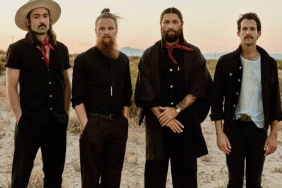The Monkees remain one of the most fascinating bands in pop history, and are, in many ways, far more interesting than The Beatles, the band they were clearly meant to emulate. They were poppy and kid-friendly, and, rather infamously, constructed by a record label and TV studio, rather than forming organically. Their TV show (1966 – 1968) was an A Hard Day’s Night-influenced kiddie romp starring the band – Davy Jones, Mike Nesmith, Micky Dolenz, and Peter Tork – playing versions of themselves. The show is immensely enjoyable, and I particularly recommend the “Fairy Tale” episode. Every episode of the show featured at least two of The Monkees’ songs.
The band was also hard-pressed to gain any sort of musical credibility. It was often circulated that they didn’t play their own instruments, nor did they write any of their own songs. Their records did often feature studio musicians, of course, but so did many pop artists’, and they did indeed write many of their songs (although Tommy Boyce and Bobby Hart did a lot of the heavy lifting).
Read This: Davy Jones (1945 – 2012)
The Monkees themselves resented their reputation of “The Pre-Fab Four,” and began to, over the course of two years, declare themselves to be a more important voice in the pop firmament than they got credit for. Their show got weirder, and they eventually, in 1968, made a feature film with director Bob Rafelson (Five Easy Pieces). The result was Head, a totally bizarre, not-at-all-kid-friendly acid trip featuring numerous songs, unconnected vignettes, and abstract musings on war, commercialism, identity, and death.
The film came packaged, of course, with a soundtrack record, which we here at SoundTreks will now gleefully traverse. Not all tracks will be reviewed, as half of them are merely dialogue and sound effects from the film. But there were eight songs, and we shall discuss them below.
Track 2. “Porpoise Song (Theme from Head)”
The theme song for Head was this wonderfully dreamy, organ-heavy ballad that evokes late-era Beatles more than some actual Beatles songs. There were a lot of songs in the 1960s that dealt with what is “real,” perhaps inspired by a disconnection with the pervious generation, paired with an art-heavy dissociated drug state. Strawberry fields, nothing is real. “Porpoise Song” is one of these. When other bands sing on the topic of real-ness, it sounds philosophical and/or academic. The Monkees, however, had every reason to sing about being “real,” seeing as they were constantly at odds with their own perceived illegitimacy. Are they a band or a commercial? Are they “real” musicians?
The answer is, of course, yes. But a band has to work hard to be recognized through a bad reputation. They felt they weren’t seen as actual people. The lyric – “A face, a voice, an overdub has no choice. And it cannot rejoice,” – puts this into obvious relief. In the film, the song was paired with images of The Monkees charging onto a bridge only to throw themselves off. They are seen landing in the water below unscathed, but there is a creepy, intense suicide vibe now hanging over The Monkees. Ballsy, considering the slapstick tone of the show.
Track 3. “Ditty Diego-War Chant”
I love this chattery comic track. It sounds like a commercial for the very movie you’re watching, and was, indeed, used in the film’s trailer. It also lays out pretty damn clearly the film’s satirical intention. We are, Rafelson and The Monkees are ironically saying, just as shallow as you think we are; we know we’re pre-fab, and we have little to offer. It’s an inverted advertisement for a movie that, in the first few minutes, proved itself to be the opposite of what you assumed. It’s quick, it’s witty, and it’s fun to learn.
Track 4. “Circle Sky”
The version of “Circle Sky” from the movie is actually a live performance, and the one on the soundtrack record is a studio recording. It was written by Mike Nesmith. It’s a jumpy, bluesy number with few chord progressions in the best possible way. It’s a good one to dance and bop to. The lyrics are fun and seem kind of shallow (“Looks like we’ve made it once again”).
On its own, it’s just fun. In the movie, however, the song is followed by a hoard of rabid Monkees fans storming the stage to bodily rip them apart. There’s no blood or anything, but it’s disturbing nonetheless. The comment from the song: Have fun. The comment from the movie: When we entertain, we are to be sacrificed.
Track 6. “Can You Dig It”
Written by Peter Tork, this is the most hippie-friendly song on the the soundtrack, as Tork’s songs tended to be. It’s strangely intense, and mercifully lacking a certain breed of 1960s psychedelic drone that only sounds good in the ear of people soaked in acid. It sounds like folk taking its first baby steps toward Ravi Shankar.
Track 9. “As We Go Along”
A gentle, fireside love ballad about life being better than you assume. It has a full minute of musical introduction, and then a series of sweet, lilting lyrics like “We’ll make up our story as we go along.” I don’t think this one is meant to be a reflection of The Monkees or their career. I think it’s just a sweet love song. This song accompanies many gentle nature scenes, and features vocals by Micky Dolenz. It’s looking like each Monkee got a chance to sing or write on this record.
Track 11. “Daddy’s Song”
Written by Harry Nilsson. This song is Davy Jones’ showcase number. In the movie, he gets to wear suits, and do his signature “shuffle” in a colorful room. The song is so upbeat, you start to think that it’s cartoony and out of place. The lyrics to “Daddy’s Song” are, however, about how a son came to cope with his runaway father. It’s actually a rather sad song. Nilsson is, of course, best known for singing “Everybody’s Talkin'” from Midnight Cowboy, which is perhaps the most depressing pop song ever. So I guess it’s fitting.
“The youth of America is counting on you to point the way,” says Frank Zappa.
Track 13. “Long Title: Do I Have to Do This All Over Again”
Lyrics by Peter Tork:
Can I see my way to know what’s really real
They say time can fix things by itself
I know life’s more than just some kind of deal
Won’t you tell me what all, when my soul comes off the shelf
Didn’t I, oh, didn’t I?
If one seeks to defend Head (and its soundtrack record) as a comment on The Monkees’ legitimacy in the pop firmament, then “Long Title” would be the strongest argument. Shelved souls, packaged, pre-fab life, what’s really real. “Long Title,” however, is not a defiant number, inspired by anger. It’s upbeat and rock-y. It seems that defiance and cheer could only mix back in the 1960s.
Track 14. “Swami – Plus Strings” – Ken Thorne, etc.
This is the final track on the original record, and it’s an abstract soundscape based on snippits from the whole record, including all the previous songs, bits of dialogue, and sound effect all bound together by orchestral backup. It’s the perfect epilogue to a great record, a great listen (to those amenable to abstract soundscapes), and, in an intellectual way, a statement of self-awareness. The record is now looking back on itself in a hall of mirrors. On its own, this track would not be listenable. As the final track on the record you just listened to, it’s an awesome coda.
Which is Better? The Soundtrack or the Film?

Thanks to the snippets of dialogue and sound effects (that I omitted in this review), the soundtrack record falls a little behind; you wouldn’t get too much from those snippets if you were to hear them totally out of context. There have been many soundtrack records to include movie dialogue, from The Wizard of Oz to Pulp Fiction, and they’re often included to dictate the tone of the record beyond the song selections. Head is no different, except it’s far weirder.
Head is a fascinating movie that exists without a country. When it was released, it was rejected by Monkees’ fans, who couldn’t fall in line with the band’s deliberate destruction of their pop image, while serious music critics couldn’t take it seriously since it came from a “kiddie band.” Imagine if a pop boyband of today were to make something like Head. If , say, One Direction or 5 Seconds of Summer suddenly burst forth with a confrontational, intentionally oblique meditation on the fleeting and horrifying nature of pop fame. It would probably we as baffling and as poorly received as Head was back in the day.
Thus, the soundtrack record to Head represents, in many ways, the final word from The Monkees. They sought to tear down their image, and they succeeded. After this, Peter Tork would leave the band. This is not to say The Monkees ended entirely. Indeed, they have reunited in truncated versions over the years (mostly without Michael Nesmith) to put out occasional records, and to work on individual solo records and tours. In 1996, the original our Monkees released Justus, their final record as a quartet.
Can we all finally agree that they proved themselves as real musicians?
Witney Seibold is a contributor to CraveOnline and co-host of The B-Movies Podcast. You can follow him on “Twitter” at @WitneySeibold, where he is slowly losing his mind.








